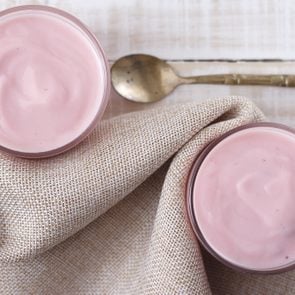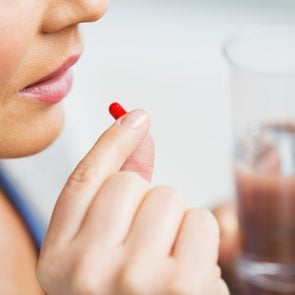Types of Probiotics and How to Pick the Right One for Your Needs, according to Gut Health Research
Updated: Jul. 05, 2022

Probiotics are a popular topic, but choosing the right one can be confusing. Here's what nutrition experts and the latest studies say to look out for, plus how to tell whether your probiotic is working.
How to choose a probiotic
Probiotics have become a much-hyped supplement for good nutrition. But so many of these healthy bacteria-filled products have come available that choosing the right one can feel complicated. That’s especially true because—like some other supplements, such as many protein powders—the National Institutes of Health (NIH) points out that probiotics don’t usually require approval from the U.S. Food and Drug Administration.
However, that doesn’t mean they don’t offer health benefits. The NIH says probiotics may help your gut’s microbiome reach a more optimal balance, which can lead to several significant health benefits. In fact, ahead of the pandemic, some medical professionals had been recommending probiotics to prevent infections in hospital patients, according to 2018 research in PLOS One. Other studies reviewed in Frontiers in Microbiology in 2020 suggested probiotics can also improve nutrient absorption, protect your heart, and potentially prevent cancer; while past research has found probiotics may help alleviate allergy symptoms. And, science has suggested there may be advantages from probiotics even beyond all these.
At the moment, there’s still plenty science is still in the process of discovering about probiotics. For example, registered dietitian Rachel Larkey, MS, RD, CDN, CLC, tells The Healthy: “Some folks benefit from taking a probiotic, and some don’t.” She says scientists aren’t entirely sure why the varied responses exist, but this may have to do with genetics and the unique way individual bodies respond to different foods and nutrients.
Research continues to advance…but in the meantime, here’s what the experts say you should look for in a good probiotic.
Also, we’ve made it easier—read Culturelle Probiotic: Why It’s the Best, Say Many Shoppers and Nutrition Pros
What are probiotics?
In a nutshell, probiotics are live microorganisms that can help diversify and balance your gut flora (the bacteria in your digestive system). An analysis published in BMJ explains the importance of this balance, noting that having enough good bacteria is essential for digesting food. Meanwhile, low bacterial diversity—called “dysbiosis”—has been associated with a wide range of health problems, like inflammatory bowel disease, diabetes, arthritis, and obesity.
There are plenty of reasons your gut bacteria balance can fall out of whack, according to research published in Frontiers in Endocrinology. These can include dietary changes, smoking, alcohol use, stress and anxiety, antibiotics use, poor sleep patterns, and pesticide or chemical ingestion (one reason it’s so important to wash your fruits and vegetables safely).
So if you’re looking to get your gut flora on track, here’s a download of wisdom. As with any diet change, we recommend you consult with your doctor before you start on a probiotic.
For more probiotic basics, read What Are Probiotics? It’s Time to Get the Facts Straight
Making sense of probiotic strains
There are about 8,000 different types of probiotics, according to a 2019 article in Nature Medicine—and likely, more remain undiscovered. These strains fall into several categories (genera) frequently used in probiotic products.
The most common (and well-researched) are Lactobacillus, Bifidobacterium, and Saccharomyces. You may come across strains of Streptococcus, Enterococcus, Escherichia, and Bacillus as well, though research on these types is more limited (and primarily relies on animal studies).
Lactobacillus
This type of good bacteria plays an important role in food digestion. It may also help prevent gut problems like infection, irritable bowel syndrome (IBS), and cancer, according to research published in Frontiers in Microbiology.
While there are many types in this genera, the strain Lactobacillus rhamnosus is one of the most heavily studied, says Dana Ellis Hunnes, PhD, MPH, RD, Senior Dietician at UCLA Medical Center and author of Recipe for Survival. The text Integrative Medicine outlines what studies to date have uncovered: supplementing with this probiotic strain may alleviate diarrhea, prevent atopic dermatitis, protect against urinary tract infections, and improve gut health. But scientists continue to explore the potential health benefits of other Lactobacillus strains, too—such as that it may ward off flu and the common cold.
Bifidobacteria
These friendly bacteria help the body break down fiber and are essential for keeping your colon in great shape. December 2021 research published in Frontiers in Bioengineering and Biotechnology suggested that Bifidobacteria may also help prevent infection, gut inflammation, and constipation (even in people with lactose intolerance) and improve nutrient absorption in the gut.
While more research is needed in humans, multiple strains of this bacteria—including B. adolescentis, B. breve, and B. longum—have even been shown to relieve symptoms of stress, anxiety, and depression.
17 Things Psychologists Wish People Knew About Depression
Saccharomyces
Saccharomyces is actually a probiotic yeast (the strain Saccharomyces cerevisiae, sometimes called “baker’s yeast,” is what gets used in processes like bread-baking and winemaking).
Researchers have found that another type—Saccharomyces boulardii—is particularly effective in treating gut problems, like diarrhea, that can occur due to antibiotic use. According to 2020 research published in the Journal of Fungi, this yeast can help to restore the normal balance of bacteria that gets disturbed during antibiotic treatment.
12 Medical Reasons You Keep Getting Diarrhea
Probiotic strains: the more, the better?
So if all these strains have their own unique benefits, why not just mix them? Well, let’s start here: probiotics are generally marketed as either single-strain or multiple-strain products. Because many different types of bacteria naturally occur in the gut, it’s thought that multi-strain mixtures should be more effective. However, this assumption remains unsubstantiated, according to research published in Digestive Diseases and Sciences.
The review of studies states that “in most cases, multi-strain mixtures were not significantly more effective than single-strain probiotics.” Still, 2019 research published in Biology urged the scientific community to keep at this question. It suggested that mixing certain probiotic strains together would likely produce beneficial effects—but which types of bacteria work best in unison is largely still up for debate.
How many probiotic CFUs do I need?
Probiotic doses are measured in CFUs, or colony-forming units. This figure, generally between one and 50 billion, indicates the number of viable, live bacteria cells present within a given product. Again, more research is needed to understand ideal probiotic doses—though a 2017 review of studies published in Beneficial Microbes suggested that a higher CFU isn’t necessarily better. The research pointed to a study that suggested 10 billion CFU of Lactobacillus rhamnosus may be the peak effectiveness for this strain.
Checking a product’s label in full could give you more insight into how many CFUs you’re taking, according to the NIH. That’s because current regulations require manufacturers to list only the total weight—which can include both live and dead microorganisms. So to be sure you’re getting live organisms, the NIH suggests you should look for products that list the number of CFU at the end of the product’s shelf life, not only what’s present at the time of manufacture.
Is my probiotic working?
You might not be able to tell if a probiotic supplement is working, Hunnes explains. “With that said, if you’re having less bloat, are more regular, and have fewer [gastrointestinal system] side effects, it’s likely helping you,” she says.
And the experts have some tips that may improve your probiotics’ efficacy. Larkey says to eat some prebiotics during the day, as these fibrous foods—like oats, bananas, berries, legumes, and asparagus—work to feed our gut’s good bacteria.
Read The Banana Health Benefit You for Sure Weren’t Aware Of, Dietitians Reveal
Also, you may want to think twice about taking probiotics at the same time of day as an antibiotic, Hunnes adds—”Otherwise, you’re just killing the probiotics.” She advises that it’s best to wait about six hours after taking an antibiotic.
Larkey also recommends including probiotic foods like yogurt, kefir, and kombucha in your diet. But don’t worry if you’re not a fan of fermented foods: here are six surprising probiotic foods and more information about why consuming bacteria-rich cuisine is so beneficial.
Are there downsides to taking a probiotic?
“Each of us has a natural level of probiotics in our intestinal tract that is unique to us,” Hunnes says. So when you take a probiotic, you do potentially run the risk of “crowding out” the balance you naturally have.
That said, it’s still unclear what effect this could have on your overall health. According to the NIH, there’s a lack of information about the frequency and severity of probiotic side effects—so just make sure you’re taking it under your doctor’s supervision.
Now that you’re armed with a better understanding of probiotic strains and CFUs, check out a few nutritionist-reviewed probiotics brands for your specific health concerns.
Sign up for The Healthy @Reader’s Digest newsletter for nutrition know-how and plenty more. Follow us on Facebook and Instagram, and keep reading:
- A Registered Dietitian Just Planned a Day’s Worth of Meals for Balanced Skin
- How Safe Is Your Produce? Authorities List the 12 Dirtiest—and 15 Cleanest—Fresh Groceries of 2022
- Dietitians Just Shared 6 Tips to Help Your Gut Absorb Vitamin D
- The Best Foam Roller to Accelerate Your Recovery, according to Trainers




















